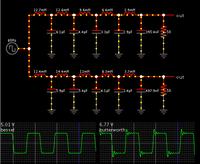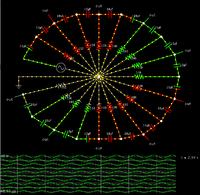- Joined
- Apr 1, 2011
- Messages
- 15,203
- Helped
- 2,901
- Reputation
- 5,814
- Reaction score
- 2,984
- Trophy points
- 1,393
- Location
- Minneapolis, Minnesota, USA
- Activity points
- 113,924
Using inductors and capacitors as a lumped approximation to a transmission line is a well known technique for delaying signals (it was one of the example circuits I showed earlier).
Yes, you posted the 'Delay amp.pdf' configuration. It is made from several coils strung in series, with capacitors to ground in between.
The arrangement is similar to the multi-pole Butterworth filter (low pass) which I find among the circuits that come with Falstad's simulator.
I strung together several stages and made a simulation.

The red coloring moves from left to right continuously.
Resonant action is obvious in the animation. It causes some stages to 'bend' its sine wave so it is a little ahead or behind where it ought to be.
The volt levels do not decrease so quickly. With resonant action going on, there may even be some stages swinging to a higher level than the original signal.
It dawns on me that this is the concept that a transmission line takes advantage of, in order to minimize signal loss.



